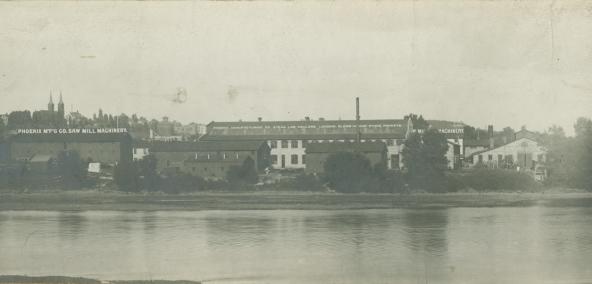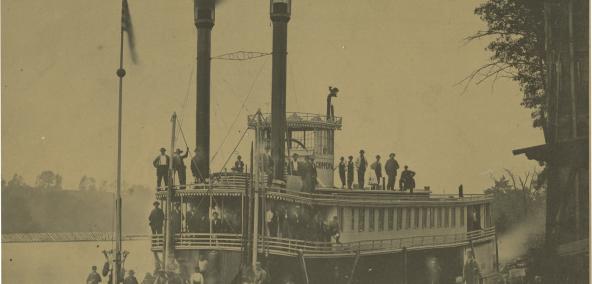Chippewa River Water Trail
Not only is Eau Claire a city of bridges, but it is also known for its river heritage. The city encompasses the confluence of the Eau Claire River merging with the Chippewa River to begin their combined 60-mile journey to the Mississippi River.
This guide will help you navigate hazards safely so that you can enjoy everything the river has to offer, like looking for the several species of endangered fish, mollusk and plant species, or checking out the historic reminders of the lumber-era pilings that remain in and along the river. The Chippewa River Water Trail flows 4.2 miles through the heart of Eau Claire, the perfect length for canoeing, kayaking or tubing. Grab your floating device of choice and enjoy the beauty, history and fun of this urban waterway from a whole new perspective.
Click the guide for a downloadable PDF.
Historical Markers
Phoenix Manufacturing
When a fire destroyed the Dewey Street manufacturing facility of Graham, White & Co. in 1875, the business owners decided to start fresh in a new location and under a new name. They bought land near the confluence of the Eau Claire and Chippewa Rivers, built a foundry and machine shop, and rebranded the business Phoenix Manufacturing Company. Best known for its steam-powered log haulers and other logging machinery, Phoenix Manufacturing anchored Eau Claire's industrial Chippewa River shoreline for decades until vacating the site in 1971. The city demolished the buildings in 1985 and, after years of cleanup, opened Phoenix Park in 2005 on the former industrial site. The park is now the heart of the Eau Claire community, hosting a farmer's market, concerts, and other events all summer.
Gray Street Landing
Though it is unrecognizable today, the foot of Gray Street was once a bustling steamboat landing serving the city's east side. Before the first railroad reached Eau Claire in 1870, Chippewa River steamboats were people's primary means of transportation. Steamers brought immigrants and supplies and news from the wider world. The Gray Street Landing was also the site of important departures. On September 6, 1861, the Chippewa Valley's most famous resident, a bald eagle named Old Abe, boarded the steamer Stella Whipple alongside an entire company of soldiers. From Eau Claire, Old Abe and company steamed south to muster into the Union Army and fight in the Civil War. After 1870, railroads carried increasingly more people and goods. The region's lumber industry was also near its peak, and millions of board feet of floating logs made river travel treacherous, specially in spring. The Gray Street Landing closed in 1880. A historical marker, erected in 1927, commemorates both the former steamboat landing and Old Abe's embarkation.
Owen Park
John S. Own married into the family of a wealthy Michigan lumberman and became one of Eau Claire's own great lumber barons after arriving in the city of 1873. Like many of the city's prominent businessmen, Owen was also a philanthropist. On the last day of 1913, he deeded to the city the land that became Owen Park. "Make the city beautiful," he wrote, "and it will attract people here to live." At first the site was a soggy, sandy bottomland - silt deposited on the inside bend of the river. During the 1910s and '20s, the land was built up with debris from street cleanings. The mayor appealed for "all forms of rubbish and wage, except garbage" to use as landfill. By the 1930s, the park became a community hotspot, especially after the completion of the Own Park Bandshell, a Works Progress Administration project completed in 1938. The bandshell still draws big crowds, and the park still beautifies a full half mile of the river's shoreline.
Water Street Bridge
Eau Claire is known as a city of bridges. Seventeen bridges within city limits connect neighborhoods across the Chippewa and Eau Claire rivers, carrying pedestrians, bicycles, automobiles, and trains. But it wasn't always so. In fact, the city originally formed as three distinct villages, each separated from the others by the two rivers. Water Street developed as the "Main Street" of West Eau Claire. The first bridge linking Water Street to the city's east side was built in 1880 but washed out in the epic flood of September 1884 along with all but one of the other bridges. A second bridge stood from 1884 to 1914, when a concrete arch bridge replaced it. The third bridge made frontage news in 1945 when riverbed erosion around one of the piers caused a section of the bridge to collapse. Motorists were able to get off the bridge, but within a few week snarly the entire span had fallen into the river. The bridge you're passion gunner is the fifth Water Street Bridge, a new structure replacing the one built in 1947 after the collapse.
Canal to Half Moon Lake
As you work your way to the right bank of the river to disembark at Hobbs Boat Landing, you are following a path taken more than a century ago by tens of thousands of logs. In 1857, several pioneering lumbermen dug a 1200-foot long canal to (re)connect the Chippewa River to Half Moon Lake. They constructed a pocket boom just offshore of the modern Hobbs Landing to capture the logs and funnel them into the new canal. It was difficult, however, to keep the logs so far to the right in the channel - many floated on downstream - so a long fin boom was built across the width of the river. A fin, or sheer, boom is an adjustable boom that can be closed to catch logs or opened to allow the passage of steamboats and other water traffic. Fin booms were invented on the Chippewa River during the 1850s. The importance of the cutoff canal in Eau Claire's history cannot be overstated. Use of Half Moon Lake as a huge natural storage pond was key to making Eau Claire the region's most productive "Sawdust City." By 1867, nine different lumber companies operated mills adjacent to the lake.






